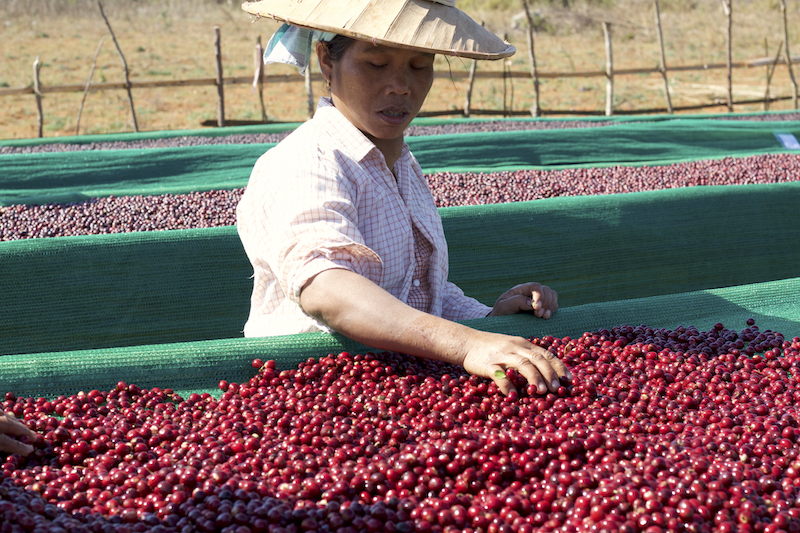On Freshness
Each coffee has a unique lifespan of deliciousness—and it's our job to find it.
A Time to Grow, A Time to Brew
As the seed of a tropical fruit—one that we source from places as distant and diverse as Myanmar and Ethiopia, Sumatra and El Salvador—your coffee's flavor is an expression of its freshness. At Blue Bottle, that freshness is our guide, and we gauge this metric not only by the time between roasting and drinking, but by whether a coffee was picked, sorted, rested, and shipped in a timely manner.
You may have noticed that our East Africa single origins most often appear in the spring and summer, whereas Colombia coffees will pop up throughout the year. This is because our Green Coffee team, led by our Buyer, Charlie Habegger, works hard to make sure that the coffee we serve in our cafes and ship to subscribers was picked at the height of its deliciousness (and hasn't been sitting in a warehouse for months in transit from its origin to one of our roasteries in the U.S. or Japan).
How Does Coffee Age?
Well-processed coffee has its cells intact and an even distribution of well-bonded moisture thought the bean. As coffees sit on the shelf, they slowly "exhale" vapor and volatile compounds. Over time, the flavor changes. First, coffees lose their more nuanced aromatics; eventually, even their basic elements of sweetness and acidity are gone.
"We are constantly tasting for freshness," says Charlie. "Each month we audit our entire inventory, blind-cupping a sample roast of each coffee to assess its fidelity to the original quality. Over time, we gain a good understanding of what coffees are the best investment in terms of shelf life; that is, which coffees are the most resilient to time and which the least. Green coffee is a living thing, more like a produce than an inert spice or candy, and each one has a unique life span based on who produced it and where it's from."
Making Deliciousness Last
Coffee quality, location of origin, processing, shipping time, storage—there are many variables affecting coffee flavor, and these variables in turn affect one another. This means that our Quality Control team must always be tasting and experimenting, not just with single origins, but blends, too. For a single origin, our team must concern themselves with the freshness of just one coffee; for blends, they must do it for two or three.
Take our Hayes Valley Espresso. "That coffee's in every cafe and in lots of drinks," says Charlie, "and the harvest for its three-component coffees are bought throughout the year. In order to maintain Hayes' signature flavor without sacrificing freshness, we've had to tweak its design over time. We've tried many things, and learned that paying attention to seasonality is what works best to maintain its deliciousness. That attention to detail locks us in for long-term success."
The Pursuit of Freshness
"Not overbuying is one of our biggest concerns because we never sell coffee after its peak freshness," says Charlie. If we buy more coffee than we can sell at the height of its deliciousness, it goes to waste—which goes against our core value of sustainability.
Luckily for us, well-produced coffees tend to have a longer shelf life than coffees of lower quality. Though this does give us more flexibility, Charlie and his team still have to hustle to make sure that the best coffees—picked in their prime, processed at just the right pace, and shipped within a very specific window—reach us in the correct quantities.
The pursuit of freshness doesn't take place at the expense of our coffees' other qualities, of course. "That's why we pay extra to vacuum-pack our Kenyasand some of our Colombias," says Charlie. "We structure things so we aren't under quality-based pressure to release them before they're ready, or after they've hit their prime."
Coffee Is About Relationships
There's nothing like coffee when it first arrives to one of our roasteries from origin. In a fresh coffee, there is an energy—a tannic quality, as Charlie describes the flavor—that's different when it's been on the shelf for awhile, one that will relax over time and be replaced with flavors reminiscent of paper or wood. "Not unlike a red wine," says Charlie.
The coffee aging process, and its effects on flavor, fluctuates depending on the kind of coffee and its origins, which is yet another reason why Blue Bottle focuses on developing strong, long-term relationships with producers. "It helps us learn what to expect from a coffee over time," says Charlie.
The way we see it, we're not just building relationships with people, but with coffees, too.

